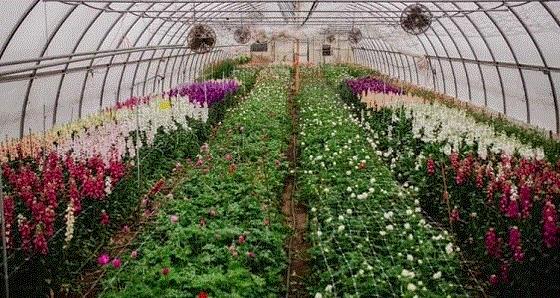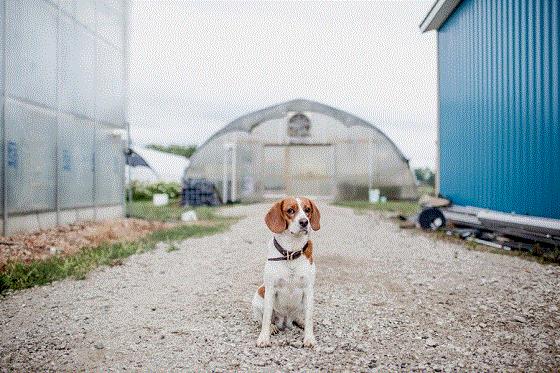Mother's Day 2022
A week from today will be Mother’s Day (I'm writing this on Sunday, during a brief lull). This is the biggest week of the year for our humble farm. Tater and the Forget Me Not crew have been feverishly cutting just about everything that looks remotely like a flower!
Quite a few crops timed well for the holiday. It is anemone, ranunculus, stock and snapdragons galore around here. Some secondary superstars are also going out this week, such as the pansies, poppies, dusty miller, scented geranium and sweet pea, to name a few. Given the messy state of the flower supply chain, I feel that, no matter what we had available, our florists would be ecstatic to receive them!
 The ranunculus timed well for Mother's Day this year. We are so grateful!
The ranunculus timed well for Mother's Day this year. We are so grateful!
The last two years have been a once-in-a-lifetime opportunity for us to show florists and consumers the advantages to locally grown flowers. Nothing drives innovation quite like necessity. If you are just getting started in flower farming, take note on the statistics below and start planning your Mother’s Day 2023 crops now, or have a strategy to sell subscriptions to capitalize on this.

Mother's Day Stats
As many of you know, Mother’s Day is one of the holiday crown jewels for the flower industry. I found this interesting
ARTICLE from the Society of American Florists that reports that Mother’s Day flowers account for 26% of holiday transactions at flower shops in the U.S., just barely trailing Valentine’s Day (30%) and Christmas (26%).
According to the National Retail Federation (NRF), consumers spent a record $28.1 billion dollars on mom last year. The NRF also found that 68% of those surveyed plan to purchase flowers this Mother’s Day. Experts estimate Americans will spend approximately $2.9 billion on flowers alone. In other words, this year is going to a big one!
There is a lot of opportunity for local farms in this data, and whether you are wholesale or retail you can make a big impact on your bottom line if you can connect to consumers during one of the biggest flower holidays of the year. Consumers and florists are looking for you, so be ready for 2023.

High Tunnel Considerations
As many of you know, Tater and I do our growing in Michigan, and we know that "growing under cover" can mean different things to different farms, depending upon your climate. Here in Michigan, the only way I know to be sure to have blooms for Mother’s Day is to grow under cover.
High tunnels and greenhouses both allow you to have product to sell during the cooler, frosty shoulder seasons and also allow you to start some crops earlier. Not only does this give you a competitive advantage, but it also allows you to reconnect with your customer base sooner in the year (assuming you aren’t growing year round).
By the way, what's the difference between a high tunnel and a freestanding greenhouse or "hoop house"? Bossman Beytes (who literally wrote the book on the topic—
the Ball RedBook Vol. 1) says it's how permanent the structure is and the sort of environmental control equipment it contains. High tunnels are lightweight temporary or semi-permanent structures, covered with a single layer of poly, often with open ends, and with limited or no environment controls. They're usually intended only for frost and/or rain projection. They're also tall enough to drive tractors inside, hence the "high tunnel" name. (He says my house is a bit too fancy to be a high tunnel, but I've been calling it that since the beginning, so will just keep on doing it here.)
Most folks in the Midwest are familiar with the benefits of high tunnels, but for those of you who are just starting your farming journey, check out this
LINK from Michigan State University Extension that explain them in more detail.
I am seeing a lot of farms in Michigan taking the leap and investing in high tunnels. The Forget Me Not crew has erected a few different types of tunnels and greenhouses over the years, and in the process I have learned that having a plan in advance is one of the keys to successful tunnel production.
 One of our high tunnels ready for Mother's Day. Crops include anemone, stock and ranunculus.
One of our high tunnels ready for Mother's Day. Crops include anemone, stock and ranunculus.
First and foremost, let’s talk about where to put your high tunnel (or greenhouse; the requirements are exactly the same). Location is a huge consideration that should not be taken lightly. In my experience, the processing area/cooler and the high tunnels are a key part of the circulation pattern on the farm. What I mean is, think about where you want harvested product to go, where you and your employees will be working, as well as ease of access to both. Think long-term, as you and your employees will be walking, hauling buckets, and hauling plants for many seasons. High tunnels will be a hub on your farm, so don’t put them in the middle of nowhere. I try to think of our farm like the spokes on a wheel. The processing area and cooler are at the center, with all the production areas radiating out from it.
This is also a valuable consideration when it comes to utilities. Granted, there are farms that are very successful with few permanent utilities in their tunnels. We heat our tunnels with natural gas, so utilities and access were another key consideration. Running utility lines is expensive, so to minimize cost we tried to minimize the distance between the power and gas sources and the high tunnel. If you have a double poly high tunnel, you will want to make sure you have a power source close to run the inflator fans. An extension cord running from your pole barn to your high tunnel in the middle of winter might not be your best bet.
Water is another key component you can’t scrimp on. Plants need water even in the winter time. Have a plan for a buried water line (once again think about distance) or where can you run a hose from.

High Tunnels (Continued)
In addition to traffic circulation pattern and utilities, think about the soil inside the house in which you'll be growing, and also drainage.
When it comes to soil, there is no cutting corners. Soil quality was an integral part of where we decided to put our tunnels and greenhouses. The high tunnels on the farm are on our most productive soil; we count on them to produce premier product. Our farm is primarily sandy loam, (which we steam sterilize), but some sites have better organic matter than others. If your soil leaves a bit to be desired, you can successfully grow in raised beds, your soil management will just be different.
You will still want to think about what soil your tunnel is sitting on because drainage is critical. There is nothing worse than a flooded high tunnel; all your hard work becomes fruitless when plants are in standing water.
When it comes to drainage we can talk about a few different strategies. You can build up the soil for your future high tunnel to raise the grade. If you do that, you will also want to think about where that water will drain to. Make sure it drains away from your tunnel, field production, and other buildings. As an added security, we ran drain tile along the length of two of our tunnels. Between raising the grade and the drain tile, we haven’t had much trouble with standing water. Where we have had trouble is when we get heavy rain—over 1 1/2 in. in one rain event—and the side vents are open, which happens primarily in the summer time. I have made this mistake more than once. Water runs down the high tunnel (ours are gothic style) and right into the side. Needless to say, it can be a soggy mess. So when you purchase a high tunnel kit, think about how the tunnel is shaped and how that influences venting and rain. Trust me, flood one of your beds once after a good rain and you won’t want to make that mistake again! Or if you forget, sometimes nature teaches you a second and third time, like me. Mistakes like this keep me grounded and humble. Keep this tip filed away—it’ll save you some headache later.

Tater is sitting in front of a high tunnel. Notice how close the pole barn and the other greenhouses are.
Other high tunnel considerations include trees and snow. We get a ton of wind on the farm, as we are pretty much surrounded by open fields. But for those of you who have trees on your farm, you will want to make sure the trees are an adequate distance from your tunnel. Tree limbs can cut plastic like a hot knife through butter. And if they're too close, they can shade your crop.
As for snow, if you are in a northern climate like we are, you will want to make sure your tunnel can withstand the snow and wind that comes with the territory. Be sure to ask your supplier some key questions about the engineering of the tunnel.
Once you have found the perfect spot on your farm for your tunnel, now you get to think about how you want to orient it: east/west, or north/south? We have spent a lot of time talking to other local growers, greenhouse manufacturers and extension specialists about this question, and to be honest, there is no one-size-fits-all answer.
Quite a few folks recommended the gable ends face north and south. Two of our tunnels are oriented this way. The main benefit to this orientation is that crops don’t shade each other. But in the winter time the narrow gable end faces south, which means you aren’t able to take as much advantage of the sun's radiant heat in the winter months. Conversely, however, a north/south orientation means the tunnel won’t heat up as much during the summer.
Now let’s talk east/west orientation. An east/west house allows in more winter sun. The long side of the tunnel faces south, so in the winter time more sunlight and heat penetrates the tunnel and it warms up faster. However, crop shadowing is a bigger concern. In the one house we have that faces east and west we ran the rows north and south to help offset this.
For those of you who have a ton of freestanding structures, let me know your experience on the orientation of your greenhouses—I’d be curious to hear more perspectives!
In another edition of Bloom Beat we will go more indepth on tunnel ventilation and amenities. But finding the ideal placement for your tunnel is a key to setting yourself up for success. And high tunnels are an awesome way to get your farm to produce more flowers earlier in the season.

In Closing
Thanks for tuning in! And enjoy the hustle and bustle of Mother’s Day week. I know it is going to be a busy one. We've already had an eventful week leading up to this one. Between our cooler breaking, scrambling to find a cooler to rent, and mechanical mishaps with our delivery van, its already been pretty exciting and stressful. But no matter what hiccups you run into, remember this:
"A diamond is a chunk of coal that did well under pressure"—Henry Kissinger
There will be some curve balls and possibly some mishaps, but no matter what life throws your way, keep your cool. Let Tater and I know how your week went, we would love to hear from you!
Happy Harvesting!
Lindsay Daschner (and Tater)
Editor-at-Large—Bloom Beat
Owner—Forget-Me-Not Farms
This email was received by 4,317 of your fellow fresh-cut flower growers!
If you're interested in advertising in Bloom Beat, contact Kim Brown ASAP and she'll hook you up.